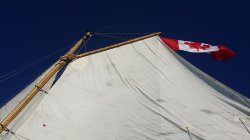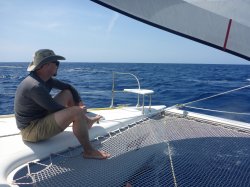
Student
Wilfred Darr
Calgary, Canada
More User info
Skipper Level II
Status: Big Time Sailor
Qualified days: 28
Posted 2017, Nov 23 05:06
Please help: one of these is wrong, but I can't figure on my own.
If you solve for current and course first and add leeway after, as per the given solution it's 6.25Kts, 40°, but if you add for leeway first and add current for course after, as per module 4 practical example, it's 6.5Kts, 42°, and I really don't have enough knowledge at this point to argue one or the other. And I realize that over a 2 hour trip, it's not that significant, but I'd like to be practicing the correct way right off the start. Please help. Thanks.

Student
Darroch Cahen
Astoria, OR, USA
More User info
Captain Level IV
Status: Big Time Sailor
Qualified days: 186
Posted 2017, Nov 24 14:59
Dumb Question:
An Easterly Wind would be plotted as 090 M ?
From the East to the West. Thus, a Standard keel boat heading up wind would be sailing generally on a course 45+ degrees off the wind; ie 045 or 135. Right ?

Student
ROBERT BALDWIN
Ann Arbor, MI, USA
More User info
Skipper Level V
Status: Big Time Sailor
Qualified days: 262
Posted 2018, Nov 23 00:47
If the river current is 2KN, The know meter of he vessel going up stream will indicate will indicate 8 knots(6 boat speed + 2 knots current) right? the actual SOG would be 4 knots (6 knots boat speed - 2 knots current), Right?

Student
ROBERT BALDWIN
Ann Arbor, MI, USA
More User info
Skipper Level V
Status: Big Time Sailor
Qualified days: 262
Posted 2018, Nov 23 02:08
Is it not true that leeway can be determined underway by noting the compass bearing of the wake and subtracting the result from the boat heading?

Student
ROBERT BALDWIN
Ann Arbor, MI, USA
More User info
Skipper Level V
Status: Big Time Sailor
Qualified days: 262
Posted 2018, Dec 06 02:02
I just cant get the diagrams. I cant see the horizontal lines and I do not see the VMC or VMG or Smg numbers. I looked at the animation. Even that makes no ssense.
What am I missing?

Student
David Koenig
Chicago, FL, USA
More User info
Skipper Level IV
Status: Big Time Sailor
Qualified days: 164
Posted 2019, Oct 05 18:42
The formula for the leeway calculation needs to be revised for clarity - the denominator is Boat Speed squared. The trailing 2 without a ^ isn't clear.
L = (k x h) / Bs^2

Student
Donald Collie
Canterbury, Victoria, Australia
More User info
Crew Level 0
Status: Sailor
Qualified days: 0
Posted 2019, Nov 13 22:57
"Set" is not a distance, it is a direction and is measured in degrees

Student
Donald Collie
Canterbury, Victoria, Australia
More User info
Crew Level 0
Status: Sailor
Qualified days: 0
Posted 2019, Nov 24 23:04
"True Wind is the wind experienced by a person or object when stationary relative to the surface of the water. If you stop your boat for lunch and float with the tide, the wind you will feel is the true wind. "
I am having trouble with this. If you stop the boat and float with tide or current running at say 5 knots to the south and wind at 5 knots from the north, your boat will float at 5 knots southward and according to the definition above, the "true wind" will be zero, when it is in fact 5 knots from the north.
Have I missed something?

Student
Michael Boyles
Whangamata, Waikato, New Zealand
More User info
Captain Level III
Status: Big Time Sailor
Qualified days: 96
Posted 2020, May 10 04:25
Follow this link for an alternative Polar Plot dialogue:
https://www.mysailing.com.au/cruising/what-use-are-a-yacht-s-polar-plot-for-cruising
I found this alternative explanation quite enlightening, especially the practical examples.

Student
Hichem Essaafi
Chamb, Switzerland
More User info
Crew Level 0
Status: Sailor
Qualified days: 0
Posted 2020, Nov 20 13:29
I assume from what I read from the module, that CTS is "an instantaneous output and will change also with time". That would mean that CTS "strives" to keep the boat on the course line.
But there are cases where the current flows to one direction, and then reverts to the opposite direction during the estimated time of the leg. If you're lucky, this can result in negating the current effect all together, with a resulting "S" track, that can, depending on the wind direction, be more efficient than merely sticking to the course line. Are there instruments that take that effect in consideration, or is that only taken into account by weather routing software?